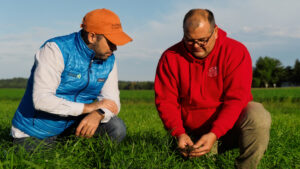Collaborative effort with the farm industry to improve farm’s environment impact
By Cate Harrington and Steve Richter, The Nature Conservancy in Wisconsin
It might surprise some to learn that farming has a significant footprint on the American landscape, from the land it takes to raise animals and crops, to the impacts on water quality and a changing climate. With impact, however, comes opportunity. Farmers across Wisconsin have a long-standing commitment to sustainability.

An example of this work is a sustainability project in Wisconsin and Michigan, called Dairy Feed in Focus. It is a collaboration among the Innovation Center for U.S. Dairy, The Nature Conservancy and Syngenta to incentivize farmers to implement best practices in feed and forage production and feed efficiency. Nestlé USA provides up to $10,000 per year to each farmer participating as a cost share incentive, similar to the cost share program a farmer-led group has for their members.
In Wisconsin, TNC works with dairy farmers who sell their milk to Foremost Farms USA dairy cooperative. TNC agronomist Ricardo Costa supports 16 farmers’ efforts to adopt soil health, grazing and feed and manure management practices that are expected to deliver climate, soil and water quality benefits on their farms.
“There is risk involved in trying something new,” Costa said. “The partners connect farmers with technical support and financial incentives provided by Nestlé USA to mitigate some of that risk and help them try new practices.”
Farmers like Theo Scholze—a fourth generation dairy farmer near Humbird, Wis.—are ready to do their part. Scholze operates Scholze Family Farms with his brother Will. They milk 550 dairy cows and farm about 2,000 acres.
“Just about every decision we make on our farm, there is a financial side to it,” he said. “But if I can make changes to help the overall global environment, I feel it is my responsibility to do that.
“Growing Italian rye grass is the most exciting change we’ve made. It doesn’t require commercial fertilizer or pesticides. We use it as a feed for one year and then leave it in place as a cover crop. It’s a very digestible plant that cows can use more efficiently. If my cow is more efficient, she’s producing less methane."
When the program originated in 2022, it had 13 farmers — 10 who were members of Wisconsin’s Foremost Farms dairy cooperative, and three who were members of Michigan Milk Producers Association cooperative. As of 2023, there are 13 more farmers participating in Michigan and seven more in Wisconsin. The goal for 2024 is to have 30 farmers, who supply milk to Foremost Farms USA, participate.
There’s a big opportunity for corporations that create products from the crops, like Nestlé USA; or create products from milk produced on a farm, like the Feed in Focus project; to contribute funds that reward dairy farms utilizing environmentally conscious practices.
“If we all contribute a little bit, we can move in a direction that is positive for the environment and positive for our industry,” Scholze said.
See the Wisconsin Climate Action web page at nature.org/WIClimateAction for a link to a video about the Dairy Feed in Focus project.
